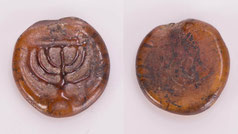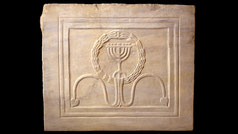ANCIENT AND NEW MENORAHS - 5th Century AD / CE
This website shows historic Menorahs from the fifth century. Menorah illustrations from other centuries: Ancient Menorahs until the 1st century, 2nd century, 3rd century, 4th century, 6th-10th century, 11th-13th century, 14th century, 15th century, 16th century, 17th century, 18th century, 19th century, 20th century, 21st century. Coins and Medals

400 AD (ca). Late Romano-Jewish. Beautiful rare gold cameo pendant comprising a sub-oval gold pendant (possibly later) with roped gold decoration at the edges. The pendant encloses a blue stone intaglio of a menorah, flanked by a bird and an amphora. Jewish communities flourished throughout the Roman Empire, where they played important roles as merchants and traders. Size: L:33mm / W:24mm ; 9.5g; Provenance: From the private collection of a Central London gentleman. Link1, Link2

5th-7th century. Seven branched candlestick menorah (Bronze casting) with horizontally ribbed stem on tripod base in the form of three dolphins with raised tails looking outward. Four double spirals between the candlestick arms. On top seven tiny pots which served as oil containers. Auction 231 (2015), Lot 33. Source: Link

5th-8th century. A black steatite pendant depicting a menorah, Levantine, triangular in shape one side depicting a menorah flanked by Arabic numbers, the opposite side with Arabic characters within an incised triangle, dashes on the edges, suspension hole at the top. 40 x 35 mm. Ex New Jersey private collection. LiveAuctioneers, 2016 Lot 0129. Source: Link

5th century. Trilingual pool (basin), white marble from Tarragona, Spain. Rectangular in shape, it has a triple inscription in Hebrew: 'Peace over Israel and over us and over our children.' Latin: 'Peace' and in Greek it is illegible. Adorned with symbols of the time: two peacocks, a penitential or horn, some also see a snake, the tree of life and a seven-branched menorah. Height = 14.50 cm; Width = 56 cm; Depth = 447 mm; Weight = 5700 gr. Museo Sefardi in Toledo, Spain. Source: Link1, Link2, Link3

5th-7th century. Ancient Jewelry. A Samaritan bronze finger ring, byzantine period. The flat circular bezel with an inscription in Samaritan script, reading: "There is none like the God Yeshurun;" together with a later Jewish circular seal engraved with a flaming seven-branched menorah on a tripod stand, formed of punched dots, the handle with a pendant loop above a knob. Ring: ½ in (1.3 cm.) long; ring size 8. Seal: 13/16 in. (2 cm.) high (2). Christie's, 2012 Lot 444. Source: Link

5th century. wearable ancient Jewish ring with interesting depiction on bezel - cross forming four menorah sybols. Good Condition; Inner diameter: 18mm; outer diameter: 22mm ring size UK P; US 8; 6gr; Provenance: Important London collection of Ancient art; formed in 1970s then passed by descent. All Items sold by Pax Romana Auctions come with professional Certificate of Authenticity. Source: Link

5th-7th century (Byzantine). A rare Jewish bronze ring depicting a 7 branched Menorah. The Menorah neatly incised into the oval bezel, the shank sturdy and well preserved with attractive patination and light deposits. Ring Size about 6. 19 x 17 x 11 mm. (3.9g). Ex Los Angeles private collection. LiveAuctioneers, March 2019, Lot 330A. Source: Link
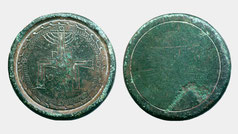
5th-7th century. Unciae Commercial Weight from the Byzantine Empire. Menorah above, all within wreath divided by four annulets; circular border containing annulets. Dimensions: 74.62g, 38mm, 9mm thick. An attractive circular commercial weight with a pleasing patina. Recessed top, two grooves around the edge. Lot 884. Numisbids. Source: Link

5th-6th century. Iconographic lead seal; circle of pearls. Rs: Menorah between Schofar, Lulav and Etrog in the Perl circle. 4,87g. In addition to the Menorah (seven-branched candelabrum) as one of the most important Jewish symbols on the seal still the shofar, made of a ram horn wind instrument, which was used in the temple, and etrog, a citrus fruit, and lulav (palm branch), important part of the Feast of Tabernacles. The Holy Land. Lot 654. Source: Link

5th-6th century? Ancient lead seal. Menorah between Lulav and Etrog in Greek transcription, hunchback. 2.17g. Münzzentrum Rheinland, Germany. Sixbid. Source: Link

5th-6th century. Judaea, Personal Lead (PB) Token of Rolanos(?). Menorah of seven branches, flanked by lulav and etrog / POΛANOY in two lines across field; palm frond above. Cf. CNG E-435, lot 401 (same dies). 3.44g, 16mm, 6h; 'desert' patina. From a private North American collection. Roma Numismatics Ltd, E-Sale 53, 7 Feb 2019. CoinArchives 2019 Source: Link1, Link2

5th-6th centuries. Lead PB token (14mm, 2.76 g, 6h) with seven-branched menorah, flanked by lulav and etrog / POΛA/NOY; palm frond above. Cf. Lanz 159, lot 654; cf. Baldwin’s 75, lot 2404 (monogram); Triton II, lot 1108 (monogram). bold gVF, earthen deposits. This lead object is clearly related to the series of late Roman/early Byzantine seals bearing a figural type on one side, with a legend in two lines in Latin or Greek on the other. Source: Link1, Link2

5th-6th century. Judaea, Personal Lead PB Token. Menorah of seven branches, (flanked by lulav and etrog). Uncertain personal name in two lines across field. Cf. CNG E-435, lot 401; cf. CNG E-245, lot 530. 1.74g, 13mm, 12h. From a private North American collection. CoinArchives, Roma Numismatics Ltd > E-Sale 53, Auction date: 7 February 2019. Source: Link1, Link2

5th-6th century. Palestine. Private document seal (Lead, 17 mm, 5.72 g, 12 h). Seven-branched menorah on base; to left, etrog above lulav; to right, shofar. Rev. Box (?). A clearly Jewish seal with an interesting, albeit unidentified, reverse depiction. Nomos AG, Auction date: 2 July 2019, Lot number: 735. Quelle: Link1, Link2

5th-7th century. Byzantine. Seal (Lead, 16 mm, 3.78 g, 1 h). Menorah of seven branches. Rev. Star (?) of six rays. Nimisbids. Source: Link

5th-6th century. Rolanos(?). Lead (PB) Token (14mm, 3.09 g, 6h). menorah of seven branches, flanked by lulav and etrog / POΛA/NOY; palm frond above. Cf. Lanz 159, lot 654; cf. Baldwin's 75, lot 2404 (monogram); Triton II, lot 1108 (monogram). VF, earthen deposits. This lead object is clearly related to the series of late Roman/early Byzantine seals bearing a figural type on one side, with a legend in two lines in Latin or Greek on the other. CoinArchives 2019, Auction 435, Lot 401. Source: Link
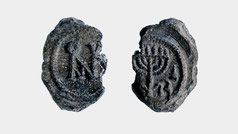
491-518 AD. A Lead Seal Impression “Bulla” depicting a menorah and the monogram of Anastasius. Dimensions: 16mm. Source: Link

5th-7th century. A Square Turquoise Glass Jar Blown in a mould decorated with a palm branch, plants, and a motif resembling a menorah. Dimensions: 7.6cm. Source: Link

5th-6th century. Byzantine Era. Mold-blown glass vessel with menorah and grain ear reliefs. Rectangular vessel with handle and funnel mouth; distinct menorah relief on two opposing sides and wheat grain ear on other opposing sides. The piece is covered with opaque iridescence fabulously reflecting all the colors of the rainbow, with an emphasis on green, blue, and purple shades. This is a spectacular, strictly Jewish artifact, Length: 2 inches (5cm); Width: 2 inches (5cm); Height: 3 ¾ inches (9.5cm). Goldbergcoins, Sale 82. Source: Link

5th-6th century, Byzantine Period. An early Jewish silver utensil. The spade-shaped blade engraved with a seven-branched flaming menorah, the twisted handle with a foliate terminus engraved with a leaf, a loop at the back for suspension. Size: 5 15/16 in. (15.1 cm) long. Christie's, Sale 1163, Lot 332. Source: Link

Various oil lamps with a Menorah. See: Ancient Menorah Oil Lamps - 5th Century

5th century. Ceramic support. The fragment corresponds to a flat bottom that was part of a wide circular source with a flat flange and made of late Gallic terra sigillata ceramics. There is a graphic precedent in the combination of the menorah and the olive branches, found in a specific text, in one of the mystic visions of the prophet Zechariah (Zechariah 4:1-3 and 4:11-14). Width = 3.30 cm; Thickness = 0.60 cm; Length = 3 cm. Made in Languedoc (France). Museo de Zaragoza, Spain. Link1, Link2

5th century. Mirror plaque in the shape of a building facade flanked by two menorahs and decorated with a row of birds. Stone and glass. A large group of plaster, pottery, and stone plaques inlaid with glass mirrors have been discovered in tombs. Some bear religious symbols – the cross, the menorah, or the figure of Tyche-Fortuna, the Roman goddess of good fortune. The plaques were believed to provide protection from evil forces by deflecting harm back upon its source. Photo © The Israel Museum, Jerusalem. Link1 Link2

5th-6th century. Fragment with depiction of the menorah. Marble Città del Vaticano, Vatican Museum (Musei Vatican). Source: Link

5th-6th century. Ancient Fragment from a synagogue at Capernaum. Note especially the three Jewish features: the seven branch menorah on a tripod, to its left an incense shovel, and to its right a ram’s horn (shophar). Below it are typical Corinthian acanthus leaves. Source: Link1, Link2, Link3, Link4, Link5

5th-7th century. The Shalom Al Yisrael Synagogue was discovered in Jericho in 1936. The mosaic floor incorporates Jewish symbols such as the Ark of the Covenant. The central
medallion consists of seven branched Menorah flanked by a Lulav and a Shofar, above the inscription. There is also a Hebrew inscription, "Peace upon Israel", after which the mosaic was named.
Source: Link1, Link2,
Link3, Link4,
Link5, Link6

5th-6th century. Ancient stone mosaic floor. Hulda. This section of a floor comes from a Jewish public building and bears the Jewish symbols common at the time: a menorah, in the middle, an incense shovel, a lulav (palm branch), a shofar and an etrog. In the middle is a blessing in Greek: "Blessing to the People". The Israel Museum. Source: Link1, Link2

5th century. Ancient menorah fragment of the mosaic floor of the synagogue Zippori. The most common motif of the menorah was in compositions of mosaic floors in the ancient synagogues of Israel and the Diaspora. Faculty of Archeology, Hebrew University, Jerusalem. Source: Link

5th-6th century. Gerasa Synagogue in Jordan (Jerash). The mosaic floor is located in the nartex (vestibule). It consists of a long oblong central panel surrounded by a narrow border. In its center is a curved menorah standing on 3 legs. The menorah is flanked by a mahta and a shofar on the right, and by a lulab and an ethrog. The Greek inscription, inscribed in two columns on either side of the menorah: “Holy place. Amen. Sela. Peace to the synagogue.” Center for Jewish Art. Link1 Link2 Link3

5th-6th century. Ashlar with an inscribed menorah. Close-up of the marble ashlar with the inscribed menorah, from Iznik, ancient Nicaea (today Turkey). The Greek inscription below the menorah, a Jewish version of Psalm 136:25 (Psalm 135 in the Septuagint), was published in Berlin in 1943, with minor mention of the lampstand. COJS. Source: Link1, Link2, Link3

5th-6th century. One of the oldest examples of Judaism in the Iberian peninsula, this fifth-century bas-relief, in Ronda, Málaga, Spain. Greek Inscription: "ΜΙΧΑΛ", a Jewish maiden name Michal (according E. Kitzinger). Dimensions: width: 21.5 cm, height: 32.5 cm, depth: 4 cm. In the 14th-15th century the Jews were called "god killers" and nearly all Jews were expelled from Spain. Museo Sefardí de Toledo in Spain. CERES. Source: Link1, Link2, Link3, Link4a, Link4b, Link5
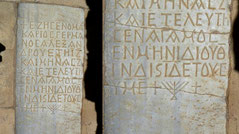
5th-6th century. A tombstone inside the Theodoros church in Avdat, remembers a 17-year-old named Germanos. Menorah flanked by two crosses. Under Byzantine rule, a citadel and a monastery with two churches were built on the acropolis of Avdat (Israel). Saint Theodore’s Church is the most interesting Byzantine relic in Avdat. Marble tombstones inserted in the floor are covered with Greek inscriptions. St. Theodore was a Greek martyr of the 4th century. Link1, Link2, Link3

5th-6th century. Screen in Ashdod (Israel). In basilical synagogues, which date to the late 5th-6th centuries, “chancel screens” served to enclose an often broad bema that stood before an apse on the Jerusalem-aligned wall. They have been uncovered at Beit Shean A, Rehov, Ma’oz Hayyim, Ein Gedi, Gaza, Ashkelon, Hammath Tiberias, and Na’aran. Source: Link1, Link2

5th-6th century. "Epitaph of Numerius ebreus (=Numerius, a Jew)" from Naples. "Egypt-Naples. From the Orient" - Exhibition at Archaeological Museum of Naples. Text: "Here lies Numerius, a Jew, who lived for 26 years and whose soul is in peace. Shalom, Numeri(u)s, amen". Beside the little menorah with angular arms are ethrog and shofar. Source: Link

5th-6th century. "Epitaph of Pascasus" from Naples with menorah, Iulav and the shofar. "Egypt-Naples. From the Orient" - Exhibition at Archaeological Museum of Naples. Text: "Here lies Pascasus who lived, in good, about 55 years. Shalom". Right below the Latin text appears the word "Shalom" written in Hebraic characters, interspersed with the seven-arm menorah and Lulav and shofar. Source: Link1, Link2, Link3

5th-6th century. Byzantine Period. Lintel with menorahs. Dabiyya Synagogue. The lintel is decorated with two seven-branched menorahs. The right menorah is triple-legged. The left one is depicted without the base. The curving branches are connected on the top by an horizontal bar. Source: Link1, Link2

5th-6th century (?). Menorah capital at Jericho. Journal article "An Early Christian Bread Stamp" by Erwin R. Goodenough. The Harvard Theological Review. Vol. 57, No. 2 (Apr. 1964), pp. 133-137 (7 pages). Published by: Cambridge University Press on behalf of the Harvard Divinity School. Source: Link

5th century. En-Nashut Synagogue, Lintel? Architectural fragment. The stone is decorated with a seven branched menorah havinga short shaft and no base. A lion is depicted within a sunken rectangle to the left of the menorah. Center for Jewish Art. Source: Link

5th-6th century. Katzrin (Qatzrin, Qasrin), Golan synagogue, Tree of Life, menorah. Architectural details carved into the local basalt stone depicting the ‘Tree Of Life’ which is the basic design for the ‘menorah’, the candelabra, the main Jewish symbol. Photograph by Zev Radovan. Source: Link1, Link2

5th-6th century. Qasrin Synagogue B, Dressed Stone. Architectural fragment. Five-branched menorah with three-legged base. An additional unidentified object (altar shewbread table?) is depicted left of the menorah. Israel/Eretz Israel, Kaztrin (Kazrin). Foto: Radovan, Zev. Center for Jewish Art. Source: Link1, Link2

5th-6th century. Katzrin, Golan synagogue, Tree of Life, menorah. Architectural details carved into the local basalt stone depicting the "Tree of Life" which is the basic design for the "menorah", the candelabra, the main Jewish symbol. Photographer: Zev Radovan, BibleLandPictures. Source: Link1, Link2

5th-6th century. Basalt jamb with Menorah with bird relief. The ruins of the ancient Jewish village of Katzrin (Kasrin, Qasrin) are located in the central Golan. The village of Katzrin was built around a spring, which still flows. The village was built during the Roman period (3rd-4th centuries) and was destroyed by the Golan earthquake of 749 AD. HolyLand-Pictures. Source: Link

5th-6th century. Katzrin, Golan synagogue menorah. Golan Heights, engraved menorah on a stone at the ancient Synagogue in Katzrin. Source: Link
Tombstones from Zoar (5th-6th Century)
ZooraThe biblical Zoar (Zo`ar, Zoara, Zoora), previously called Bela (Genesis 14:8), is an ancient settlement on the east coast of the Dead Sea. Along with Sodom, Gomorrah, Admah, and Zeboim, Zoar was one of the 5 cities slated for destruction by God; but Zoar was spared at Lot's plea as his place of refuge (Genesis 19:20-23). Segor is the Septuagint form of "Zoar". In Roman times, the city belonged to "Provincia Arabia" or "Palaestina Tertia." Although Zoar is now in the kingdom of Jordan, it had a Jewish population at the time of the second temple and in centuries afterwards. A Byzantine cemetery had numerous Greek and Aramaic inscribed grave stones. Based on the scripture / language can be distinguished between Jewish and Christian tombs. The Jewish gravestones have a special innovation on the mention of the death day. Similarly, women usually refer to the name of the father rather than, as was customary until then, the name of the man. Like most of Zoar’s Byzantine-era Jewish tombstones, the epitaph gives the name of the deceased, painted in red ochre. followed by the day, month and year of death and concludes with Hebrew expressions of peace (Shalom). The painted text surrounds a depiction of the most common symbol decorating Jewish tombstones at Zoar, the seven-branched menorah. The year number often refers to the year after the temple was destroyed, so that 70 years must always be added to the current year because the temple was destroyed in 70 AD/CE.

5th century. Most Jewish tombstones from Zoar carry Aramaic inscriptions painted in red ochre. These gravestone epitaphs give the name of the deceased, followed by the date of death and conclude with expressions of peace. Stone from 472 CE, text: "This is the tombstone of Hannah, daughter of Levi, who died on Thursday on the 19th day of the month of Sivan, in the 3rd year of the Sabbatical year, 402 years since the destruction of the Temple. Peace upon Israel Peace." 402+70=472. Link1 Link2 Link3

5th century. Jewish tombstone from Zoar. The often brightly colored and intricately decorated stones are a treasure trove of information about these two communities during the fourth to sixth centuries C.E. when Zoar (then known as Zoara or Zoora) was the seat of a major Christian bishopric and also home to a significant Jewish population. Source: Link

5th century. Tombstone of Hannah, Zoar, Southern Dead Sea, 439 CE (sandstone & red pigment). Inscription: “This is the tombstone of Hannah, daughter of Ha[niel] the priest, who died on the Sabbath, the first festival day of Passover, on the 15th day of the month of Nisan, in the 5th year of the sabbatical cycle, which is the year 369 years after the destruction of the Temple. Peace. May her soul rest. Peace.” 369+70=439 C.E. The Israel Museum, Jerusalem, Israel. Source: Link1 Link2, Link3, Link4, Link5

5th century. An ancient Jewish Tombstone with Menorah from Zoar with 7 lines of Jewish-Aramaic text in red ink. The Menorah is flanked by two pigeons. Height: 28cm. Source: Link

5th century. This tombstone from Zoar belonged to a woman named Sa’adah, daughter of Pi[nchas]. Such a tombstone represents a Jewish community that thrived there. Students in an undergraduate Talmudic archaeology course spent a semester translating the Aramaic inscriptions. Mr. Friedman said the first few words were straightforward, and Ellie Schwartz, a senior, recited them: “Here rests the soul of Sa’adah, daughter of something. We don’t know the ‘something.’ ” Link1 Link2 Link3

455 AD/CE. Tombstone of the son of Megalos from Zoar, southern Dead Sea. Byzantine period. Inscription: “This is the tombstone… Son of Megalos(?), who died on the Sabbath, the twenty-fifth day of the month of Tevet, in the first year of the sabbatical year cycle, in the year three hundred and eighty-six after the destruction of the Temple. Peace.” Technique: Sandstone and red pigment. The Israel Museum, Jerusalem. Source: Link1, Link2, Link3, Link4
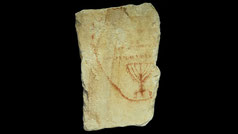
5th (or 4th?) century. Jewish Tombstone from Zoar with Aramaic Epitaph and with Aramaic inscription and a 7-branched candelabrum (menorah) in red ink. From Ancient Palestine. Material: Limestone. Measurements: 5 1/4 x 9 x 2 3/16 inches. Image © Middlebury College Museum of Art, Vermont. Source: Link
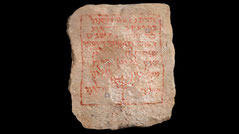
460 AD. Tombstone of Yehuda from Zoar. Text: "May rest the soul of Yehuda the priest. The son of Ab…ma who died the third day of the month of Kislev. In the fifth year of the Sabbatical cycle which is the year 300 hundred and 90 years after the destruction of the Temple. May he hold the altar and wake up to the voice of the announcer of peace. Peace Peace Peace" 390+70=460 CE. Source: Link1, Link2, Link3
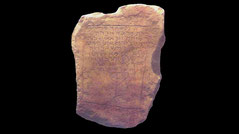
5th century. This grave stone from Zoar is dated to 374 years after the destruction of the Second Temple, which is 442-443 CE, as we learn from the inscription. Notice not only the Hebrew writing, but also the menorah below the writing. The menorah was a well known, commonly used Jewish symbol in ancient times. The writing is similar in the form of the letters to that on the Dead Sea scrolls. It is readable to Hebrew readers today, although somewhat difficult. Hecht Museum Haifa. Source: Link

5th-6th century. Tombstone with menorah from the ancient city of Zoar which mentions the name of the deceased and counts how many years since the Destruction of The Temple. The Living Torah Museum. Source: Link

427 AD. Tombstone from Zoar. The first part of the text is missing: "[this tombstone of X...son/daughter of Y who died...on day Z (of the Sabbatical)] 26 days in the month of Nissan (1st month) in the year of the Shemitah, year 3 hundred 57 years to the destruction of the temple. Shalom, Shalom." 357 + 70 + 427 CE. Illustration from the "Journal Article, Aramaic Tombstones from Zoar" by Joseph Naveh (Jstor.org). Source: Link1, Link2
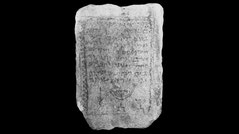
505 AD. Gravestone of Haifu from Zoar. Text: "May rest the soul of Haifu the daughter of …, who died on Tuesday, the 11th day of Elul, in the …year of the Sabbatical cycle that is the year 435 after the destruction of the Temple. Peace Peace Upon Israel, Peace!" 435 + 70 = 505. From the Hebrew book "Aramaic Tombstones from Zoar" by Joseph Naveh. Source: Link1, Link2, Link3
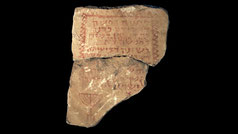
514 AD/CE. Tombstone of Hasadiah the Priest from Zoar, southern Dead Sea, Byzantine period. Inscription: “May the soul of Hasadiah the Priest son of Dematin rest, who died on Thursday, the 5th of Av, in the 4th year of the sabbatical cycle, which is the year 445 after the destruction of the Temple. Peace on Israel. Peace.” Technique: sandstone and red pigment. Photo © The Israel Museum, Jerusalem. Source: Link1, Link2, Link3
Menorah Pictures from other Centuries:
Until the 1st, 2nd, 3rd, 4th, 6th-10th, 11th-13th, 14th, 15th, 16th, 17th, 18th, 19th, 20th, 21st Century
Note: It's nice to see the menorah pictures. However, according to the Bible Jesus (Hebrew Yeshua) is the true spiritual meaning behind the physical Menorah. He is the true and eternal spiritual
light: "I am the light of the world. Whoever follows me will never walk in darkness, but will have the light of life" (John 8:12). The menorah also symbolizes the Tree of Life, because
Jesus is the way to life: "I am the way, and the truth, and the life. No one comes to the Father except through me" (John 14:6). Jesus' Word and the Bible are the light in this world. "Your word is a lamp to my feet and a light to my path" (Ps
119:105 and John 1:1-17).
Copyright info and disclaimer: All content and all photos from ancient and new menorahs provided on this website is for informational purposes only. It is not allowed to publish photos from this website on other websites or printed literature. Please always use only the original sources of the photos. We make no representations as to the accuracy or completeness of any information on this website or found by following any link on this website. We will not be liable for any errors or omissions in this information. We will not be liable for any losses, injuries, or damages from the display or use of this information. We can not guarantee the validity and accuracy of the information, please always check the original source. The opinions expressed from other website owners and those providing comments are theirs alone, and do not reflect the opinions of us.

